Strategic Information System
VerifiedAdded on 2023/06/12
|12
|3199
|286
AI Summary
This paper provides an analysis of Woolworths, the largest supermarket chain in Australian retail industry, and proposes a retail management information system as a solution to streamline its operations and improve customer experience.
Contribute Materials
Your contribution can guide someone’s learning journey. Share your
documents today.
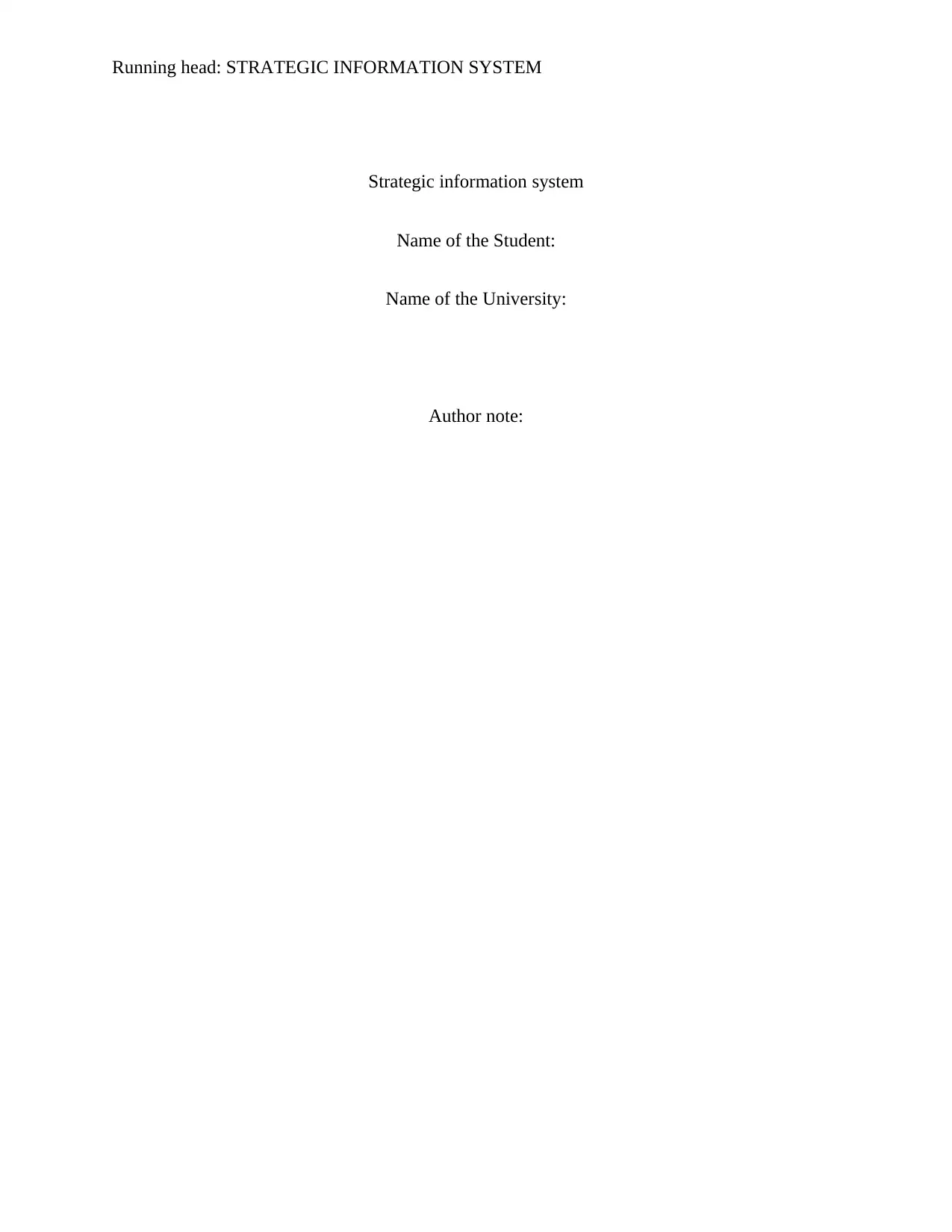
Running head: STRATEGIC INFORMATION SYSTEM
Strategic information system
Name of the Student:
Name of the University:
Author note:
Strategic information system
Name of the Student:
Name of the University:
Author note:
Secure Best Marks with AI Grader
Need help grading? Try our AI Grader for instant feedback on your assignments.
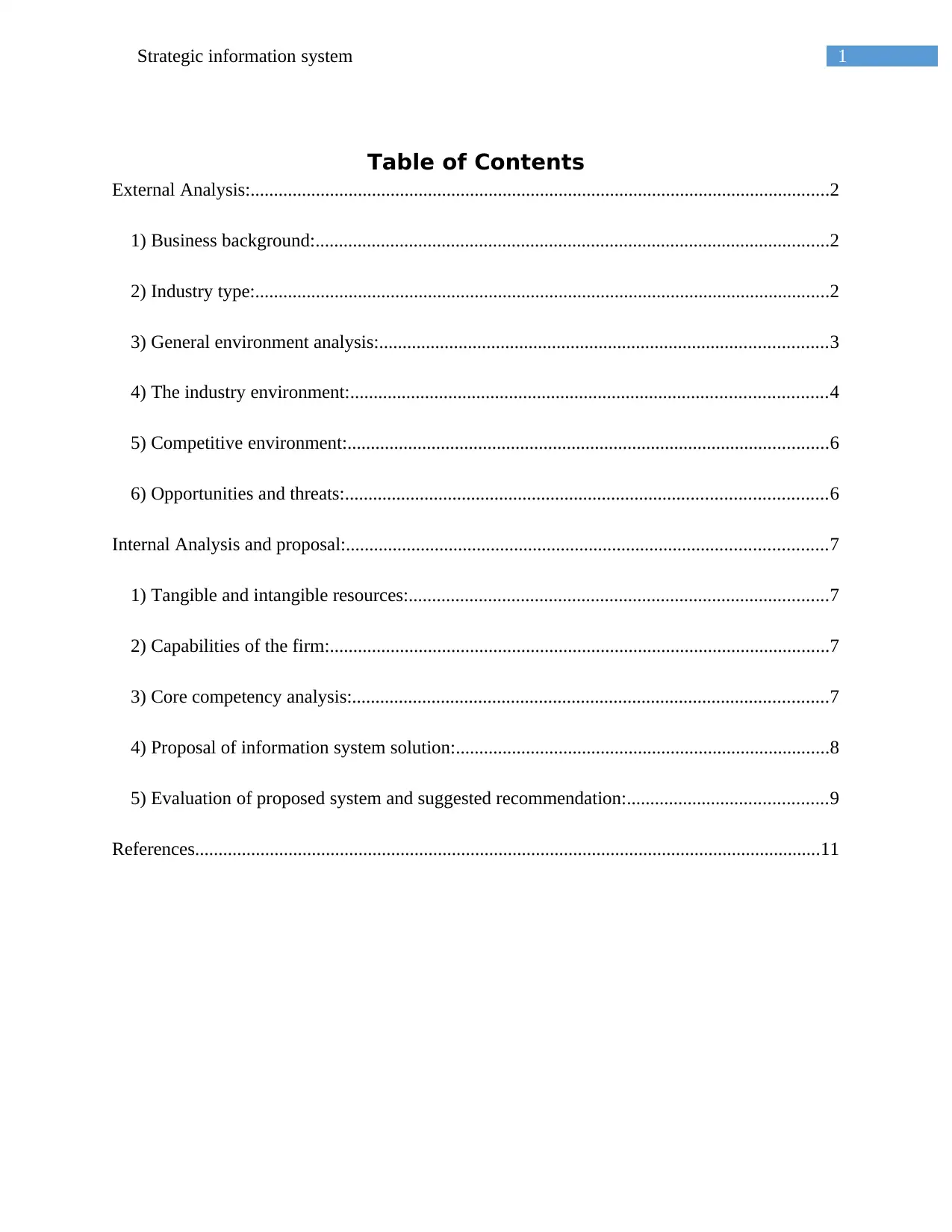
1Strategic information system
Table of Contents
External Analysis:............................................................................................................................2
1) Business background:..............................................................................................................2
2) Industry type:...........................................................................................................................2
3) General environment analysis:................................................................................................3
4) The industry environment:......................................................................................................4
5) Competitive environment:.......................................................................................................6
6) Opportunities and threats:.......................................................................................................6
Internal Analysis and proposal:.......................................................................................................7
1) Tangible and intangible resources:..........................................................................................7
2) Capabilities of the firm:...........................................................................................................7
3) Core competency analysis:......................................................................................................7
4) Proposal of information system solution:................................................................................8
5) Evaluation of proposed system and suggested recommendation:...........................................9
References......................................................................................................................................11
Table of Contents
External Analysis:............................................................................................................................2
1) Business background:..............................................................................................................2
2) Industry type:...........................................................................................................................2
3) General environment analysis:................................................................................................3
4) The industry environment:......................................................................................................4
5) Competitive environment:.......................................................................................................6
6) Opportunities and threats:.......................................................................................................6
Internal Analysis and proposal:.......................................................................................................7
1) Tangible and intangible resources:..........................................................................................7
2) Capabilities of the firm:...........................................................................................................7
3) Core competency analysis:......................................................................................................7
4) Proposal of information system solution:................................................................................8
5) Evaluation of proposed system and suggested recommendation:...........................................9
References......................................................................................................................................11
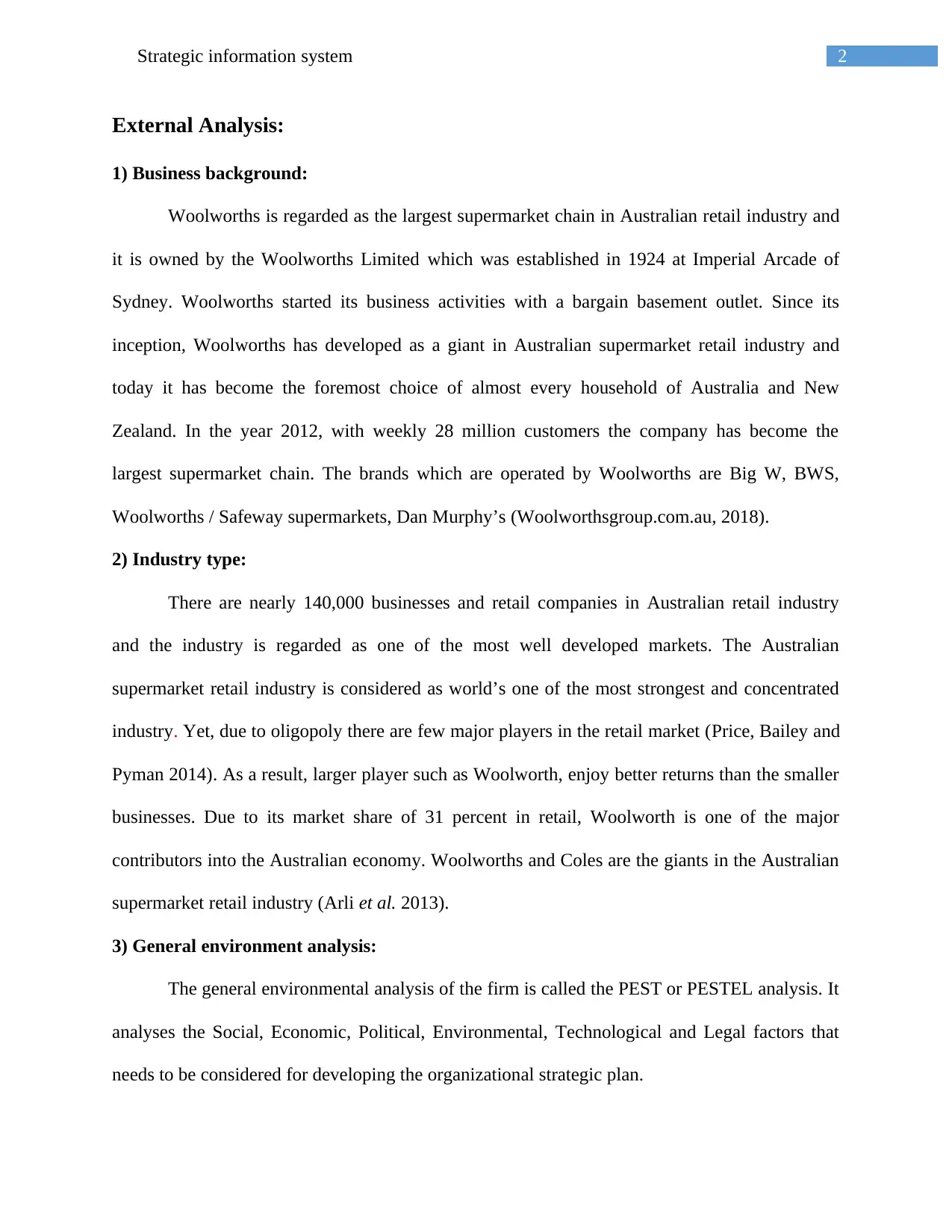
2Strategic information system
External Analysis:
1) Business background:
Woolworths is regarded as the largest supermarket chain in Australian retail industry and
it is owned by the Woolworths Limited which was established in 1924 at Imperial Arcade of
Sydney. Woolworths started its business activities with a bargain basement outlet. Since its
inception, Woolworths has developed as a giant in Australian supermarket retail industry and
today it has become the foremost choice of almost every household of Australia and New
Zealand. In the year 2012, with weekly 28 million customers the company has become the
largest supermarket chain. The brands which are operated by Woolworths are Big W, BWS,
Woolworths / Safeway supermarkets, Dan Murphy’s (Woolworthsgroup.com.au, 2018).
2) Industry type:
There are nearly 140,000 businesses and retail companies in Australian retail industry
and the industry is regarded as one of the most well developed markets. The Australian
supermarket retail industry is considered as world’s one of the most strongest and concentrated
industry. Yet, due to oligopoly there are few major players in the retail market (Price, Bailey and
Pyman 2014). As a result, larger player such as Woolworth, enjoy better returns than the smaller
businesses. Due to its market share of 31 percent in retail, Woolworth is one of the major
contributors into the Australian economy. Woolworths and Coles are the giants in the Australian
supermarket retail industry (Arli et al. 2013).
3) General environment analysis:
The general environmental analysis of the firm is called the PEST or PESTEL analysis. It
analyses the Social, Economic, Political, Environmental, Technological and Legal factors that
needs to be considered for developing the organizational strategic plan.
External Analysis:
1) Business background:
Woolworths is regarded as the largest supermarket chain in Australian retail industry and
it is owned by the Woolworths Limited which was established in 1924 at Imperial Arcade of
Sydney. Woolworths started its business activities with a bargain basement outlet. Since its
inception, Woolworths has developed as a giant in Australian supermarket retail industry and
today it has become the foremost choice of almost every household of Australia and New
Zealand. In the year 2012, with weekly 28 million customers the company has become the
largest supermarket chain. The brands which are operated by Woolworths are Big W, BWS,
Woolworths / Safeway supermarkets, Dan Murphy’s (Woolworthsgroup.com.au, 2018).
2) Industry type:
There are nearly 140,000 businesses and retail companies in Australian retail industry
and the industry is regarded as one of the most well developed markets. The Australian
supermarket retail industry is considered as world’s one of the most strongest and concentrated
industry. Yet, due to oligopoly there are few major players in the retail market (Price, Bailey and
Pyman 2014). As a result, larger player such as Woolworth, enjoy better returns than the smaller
businesses. Due to its market share of 31 percent in retail, Woolworth is one of the major
contributors into the Australian economy. Woolworths and Coles are the giants in the Australian
supermarket retail industry (Arli et al. 2013).
3) General environment analysis:
The general environmental analysis of the firm is called the PEST or PESTEL analysis. It
analyses the Social, Economic, Political, Environmental, Technological and Legal factors that
needs to be considered for developing the organizational strategic plan.
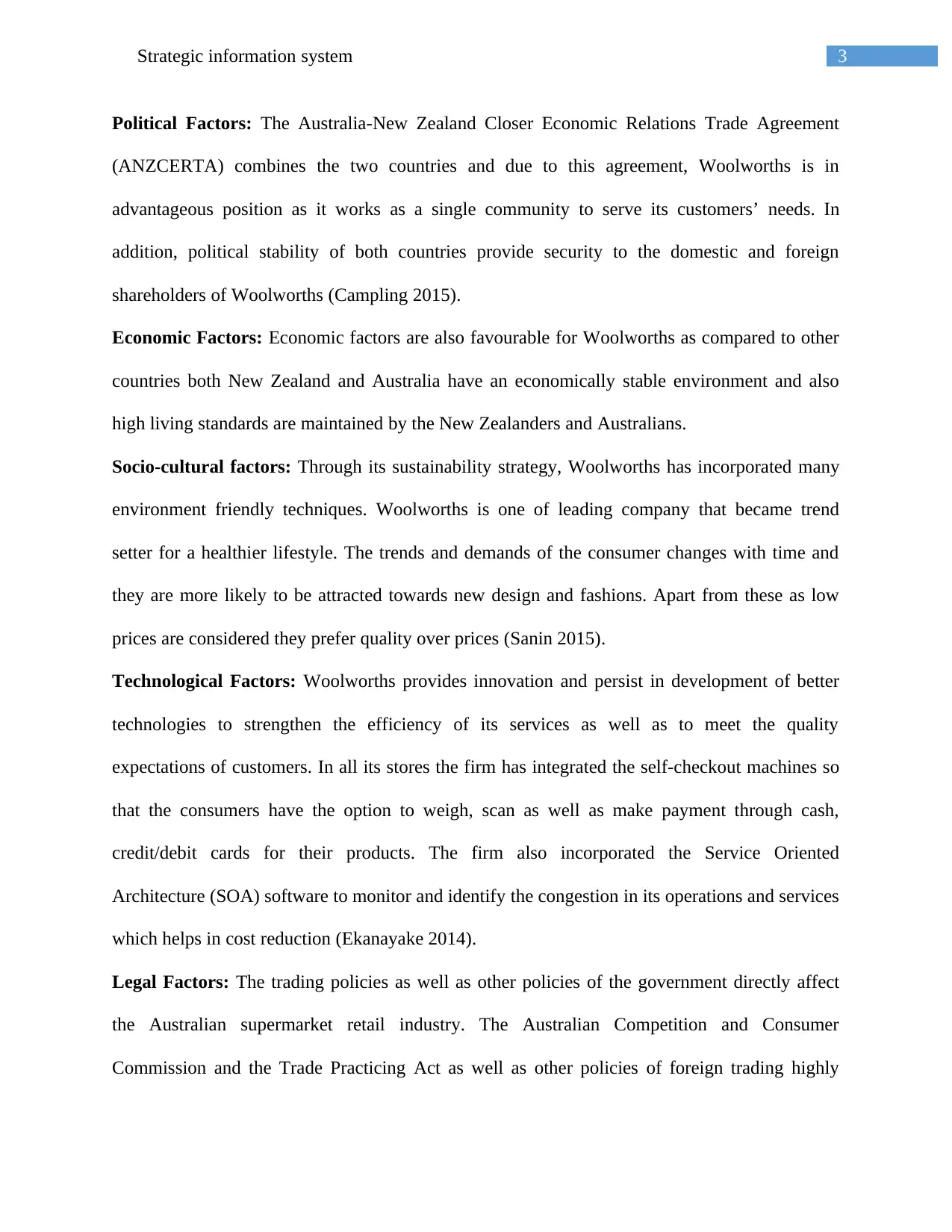
3Strategic information system
Political Factors: The Australia-New Zealand Closer Economic Relations Trade Agreement
(ANZCERTA) combines the two countries and due to this agreement, Woolworths is in
advantageous position as it works as a single community to serve its customers’ needs. In
addition, political stability of both countries provide security to the domestic and foreign
shareholders of Woolworths (Campling 2015).
Economic Factors: Economic factors are also favourable for Woolworths as compared to other
countries both New Zealand and Australia have an economically stable environment and also
high living standards are maintained by the New Zealanders and Australians.
Socio-cultural factors: Through its sustainability strategy, Woolworths has incorporated many
environment friendly techniques. Woolworths is one of leading company that became trend
setter for a healthier lifestyle. The trends and demands of the consumer changes with time and
they are more likely to be attracted towards new design and fashions. Apart from these as low
prices are considered they prefer quality over prices (Sanin 2015).
Technological Factors: Woolworths provides innovation and persist in development of better
technologies to strengthen the efficiency of its services as well as to meet the quality
expectations of customers. In all its stores the firm has integrated the self-checkout machines so
that the consumers have the option to weigh, scan as well as make payment through cash,
credit/debit cards for their products. The firm also incorporated the Service Oriented
Architecture (SOA) software to monitor and identify the congestion in its operations and services
which helps in cost reduction (Ekanayake 2014).
Legal Factors: The trading policies as well as other policies of the government directly affect
the Australian supermarket retail industry. The Australian Competition and Consumer
Commission and the Trade Practicing Act as well as other policies of foreign trading highly
Political Factors: The Australia-New Zealand Closer Economic Relations Trade Agreement
(ANZCERTA) combines the two countries and due to this agreement, Woolworths is in
advantageous position as it works as a single community to serve its customers’ needs. In
addition, political stability of both countries provide security to the domestic and foreign
shareholders of Woolworths (Campling 2015).
Economic Factors: Economic factors are also favourable for Woolworths as compared to other
countries both New Zealand and Australia have an economically stable environment and also
high living standards are maintained by the New Zealanders and Australians.
Socio-cultural factors: Through its sustainability strategy, Woolworths has incorporated many
environment friendly techniques. Woolworths is one of leading company that became trend
setter for a healthier lifestyle. The trends and demands of the consumer changes with time and
they are more likely to be attracted towards new design and fashions. Apart from these as low
prices are considered they prefer quality over prices (Sanin 2015).
Technological Factors: Woolworths provides innovation and persist in development of better
technologies to strengthen the efficiency of its services as well as to meet the quality
expectations of customers. In all its stores the firm has integrated the self-checkout machines so
that the consumers have the option to weigh, scan as well as make payment through cash,
credit/debit cards for their products. The firm also incorporated the Service Oriented
Architecture (SOA) software to monitor and identify the congestion in its operations and services
which helps in cost reduction (Ekanayake 2014).
Legal Factors: The trading policies as well as other policies of the government directly affect
the Australian supermarket retail industry. The Australian Competition and Consumer
Commission and the Trade Practicing Act as well as other policies of foreign trading highly
Secure Best Marks with AI Grader
Need help grading? Try our AI Grader for instant feedback on your assignments.
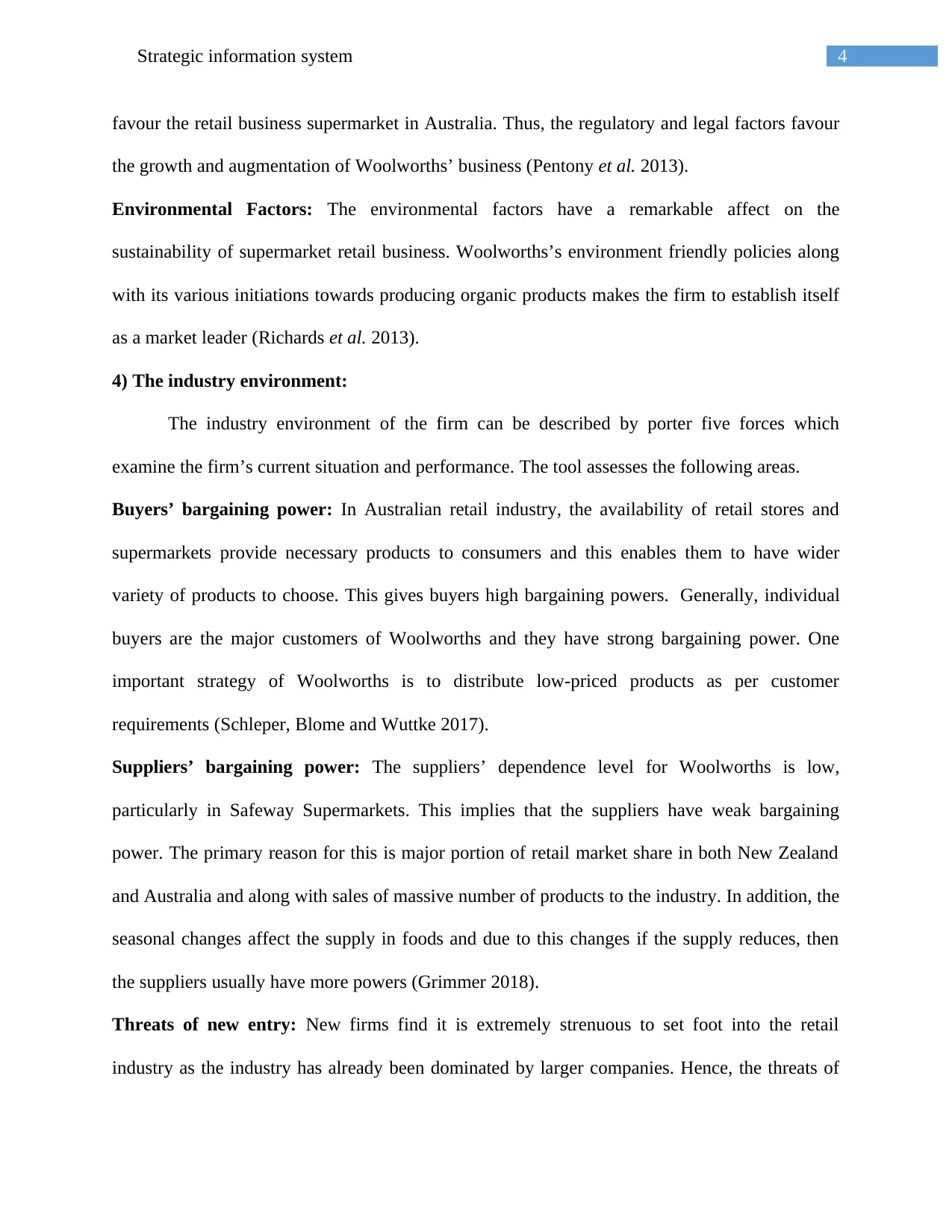
4Strategic information system
favour the retail business supermarket in Australia. Thus, the regulatory and legal factors favour
the growth and augmentation of Woolworths’ business (Pentony et al. 2013).
Environmental Factors: The environmental factors have a remarkable affect on the
sustainability of supermarket retail business. Woolworths’s environment friendly policies along
with its various initiations towards producing organic products makes the firm to establish itself
as a market leader (Richards et al. 2013).
4) The industry environment:
The industry environment of the firm can be described by porter five forces which
examine the firm’s current situation and performance. The tool assesses the following areas.
Buyers’ bargaining power: In Australian retail industry, the availability of retail stores and
supermarkets provide necessary products to consumers and this enables them to have wider
variety of products to choose. This gives buyers high bargaining powers. Generally, individual
buyers are the major customers of Woolworths and they have strong bargaining power. One
important strategy of Woolworths is to distribute low-priced products as per customer
requirements (Schleper, Blome and Wuttke 2017).
Suppliers’ bargaining power: The suppliers’ dependence level for Woolworths is low,
particularly in Safeway Supermarkets. This implies that the suppliers have weak bargaining
power. The primary reason for this is major portion of retail market share in both New Zealand
and Australia and along with sales of massive number of products to the industry. In addition, the
seasonal changes affect the supply in foods and due to this changes if the supply reduces, then
the suppliers usually have more powers (Grimmer 2018).
Threats of new entry: New firms find it is extremely strenuous to set foot into the retail
industry as the industry has already been dominated by larger companies. Hence, the threats of
favour the retail business supermarket in Australia. Thus, the regulatory and legal factors favour
the growth and augmentation of Woolworths’ business (Pentony et al. 2013).
Environmental Factors: The environmental factors have a remarkable affect on the
sustainability of supermarket retail business. Woolworths’s environment friendly policies along
with its various initiations towards producing organic products makes the firm to establish itself
as a market leader (Richards et al. 2013).
4) The industry environment:
The industry environment of the firm can be described by porter five forces which
examine the firm’s current situation and performance. The tool assesses the following areas.
Buyers’ bargaining power: In Australian retail industry, the availability of retail stores and
supermarkets provide necessary products to consumers and this enables them to have wider
variety of products to choose. This gives buyers high bargaining powers. Generally, individual
buyers are the major customers of Woolworths and they have strong bargaining power. One
important strategy of Woolworths is to distribute low-priced products as per customer
requirements (Schleper, Blome and Wuttke 2017).
Suppliers’ bargaining power: The suppliers’ dependence level for Woolworths is low,
particularly in Safeway Supermarkets. This implies that the suppliers have weak bargaining
power. The primary reason for this is major portion of retail market share in both New Zealand
and Australia and along with sales of massive number of products to the industry. In addition, the
seasonal changes affect the supply in foods and due to this changes if the supply reduces, then
the suppliers usually have more powers (Grimmer 2018).
Threats of new entry: New firms find it is extremely strenuous to set foot into the retail
industry as the industry has already been dominated by larger companies. Hence, the threats of
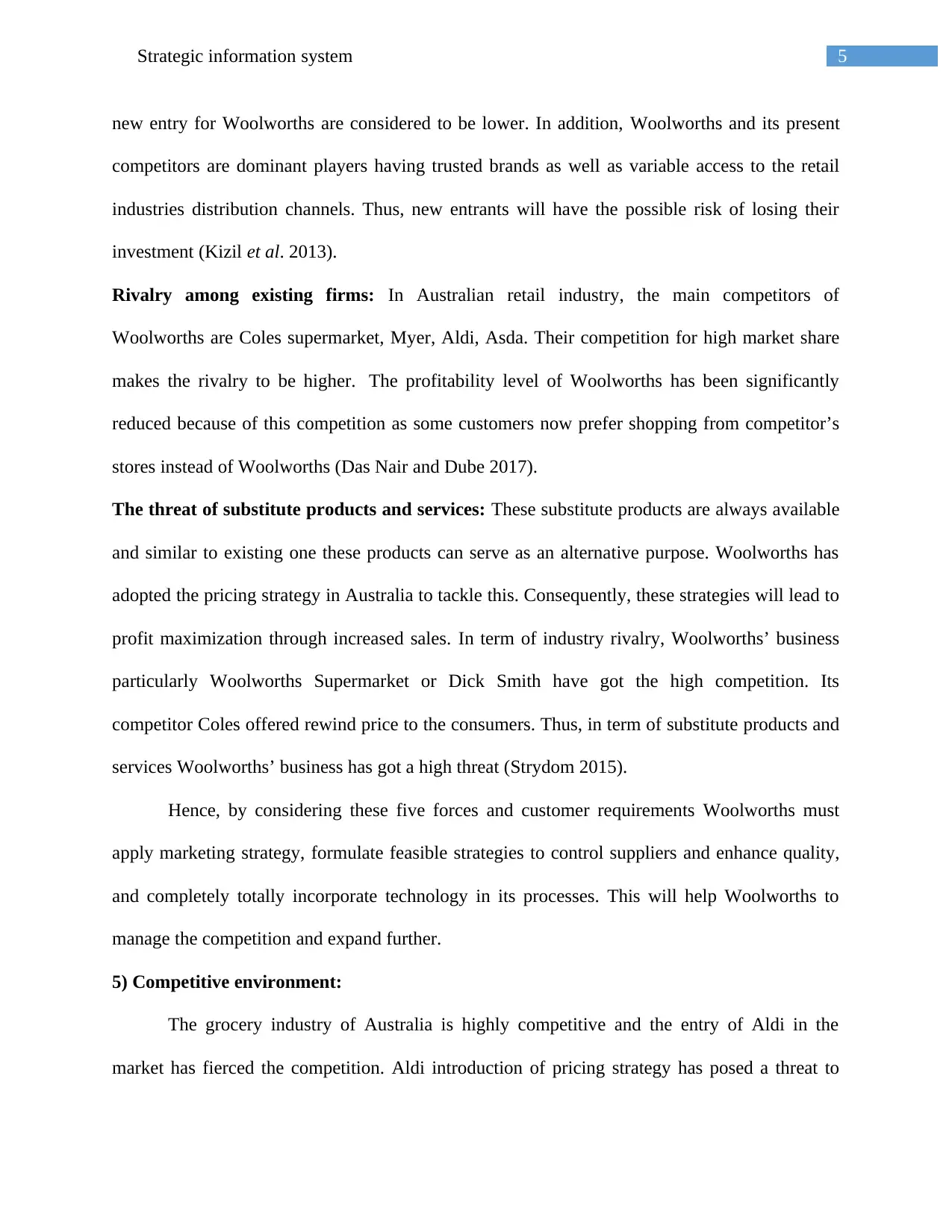
5Strategic information system
new entry for Woolworths are considered to be lower. In addition, Woolworths and its present
competitors are dominant players having trusted brands as well as variable access to the retail
industries distribution channels. Thus, new entrants will have the possible risk of losing their
investment (Kizil et al. 2013).
Rivalry among existing firms: In Australian retail industry, the main competitors of
Woolworths are Coles supermarket, Myer, Aldi, Asda. Their competition for high market share
makes the rivalry to be higher. The profitability level of Woolworths has been significantly
reduced because of this competition as some customers now prefer shopping from competitor’s
stores instead of Woolworths (Das Nair and Dube 2017).
The threat of substitute products and services: These substitute products are always available
and similar to existing one these products can serve as an alternative purpose. Woolworths has
adopted the pricing strategy in Australia to tackle this. Consequently, these strategies will lead to
profit maximization through increased sales. In term of industry rivalry, Woolworths’ business
particularly Woolworths Supermarket or Dick Smith have got the high competition. Its
competitor Coles offered rewind price to the consumers. Thus, in term of substitute products and
services Woolworths’ business has got a high threat (Strydom 2015).
Hence, by considering these five forces and customer requirements Woolworths must
apply marketing strategy, formulate feasible strategies to control suppliers and enhance quality,
and completely totally incorporate technology in its processes. This will help Woolworths to
manage the competition and expand further.
5) Competitive environment:
The grocery industry of Australia is highly competitive and the entry of Aldi in the
market has fierced the competition. Aldi introduction of pricing strategy has posed a threat to
new entry for Woolworths are considered to be lower. In addition, Woolworths and its present
competitors are dominant players having trusted brands as well as variable access to the retail
industries distribution channels. Thus, new entrants will have the possible risk of losing their
investment (Kizil et al. 2013).
Rivalry among existing firms: In Australian retail industry, the main competitors of
Woolworths are Coles supermarket, Myer, Aldi, Asda. Their competition for high market share
makes the rivalry to be higher. The profitability level of Woolworths has been significantly
reduced because of this competition as some customers now prefer shopping from competitor’s
stores instead of Woolworths (Das Nair and Dube 2017).
The threat of substitute products and services: These substitute products are always available
and similar to existing one these products can serve as an alternative purpose. Woolworths has
adopted the pricing strategy in Australia to tackle this. Consequently, these strategies will lead to
profit maximization through increased sales. In term of industry rivalry, Woolworths’ business
particularly Woolworths Supermarket or Dick Smith have got the high competition. Its
competitor Coles offered rewind price to the consumers. Thus, in term of substitute products and
services Woolworths’ business has got a high threat (Strydom 2015).
Hence, by considering these five forces and customer requirements Woolworths must
apply marketing strategy, formulate feasible strategies to control suppliers and enhance quality,
and completely totally incorporate technology in its processes. This will help Woolworths to
manage the competition and expand further.
5) Competitive environment:
The grocery industry of Australia is highly competitive and the entry of Aldi in the
market has fierced the competition. Aldi introduction of pricing strategy has posed a threat to
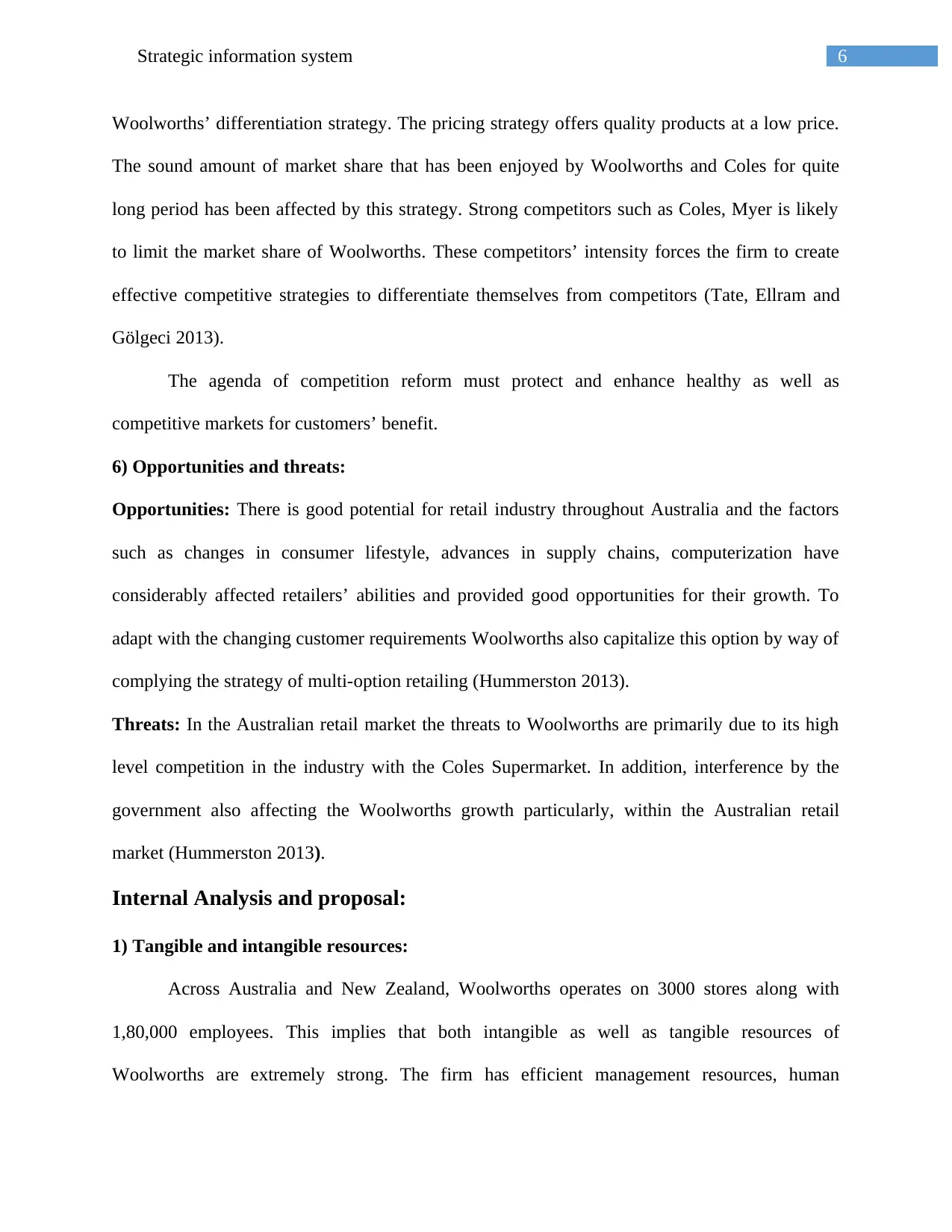
6Strategic information system
Woolworths’ differentiation strategy. The pricing strategy offers quality products at a low price.
The sound amount of market share that has been enjoyed by Woolworths and Coles for quite
long period has been affected by this strategy. Strong competitors such as Coles, Myer is likely
to limit the market share of Woolworths. These competitors’ intensity forces the firm to create
effective competitive strategies to differentiate themselves from competitors (Tate, Ellram and
Gölgeci 2013).
The agenda of competition reform must protect and enhance healthy as well as
competitive markets for customers’ benefit.
6) Opportunities and threats:
Opportunities: There is good potential for retail industry throughout Australia and the factors
such as changes in consumer lifestyle, advances in supply chains, computerization have
considerably affected retailers’ abilities and provided good opportunities for their growth. To
adapt with the changing customer requirements Woolworths also capitalize this option by way of
complying the strategy of multi-option retailing (Hummerston 2013).
Threats: In the Australian retail market the threats to Woolworths are primarily due to its high
level competition in the industry with the Coles Supermarket. In addition, interference by the
government also affecting the Woolworths growth particularly, within the Australian retail
market (Hummerston 2013).
Internal Analysis and proposal:
1) Tangible and intangible resources:
Across Australia and New Zealand, Woolworths operates on 3000 stores along with
1,80,000 employees. This implies that both intangible as well as tangible resources of
Woolworths are extremely strong. The firm has efficient management resources, human
Woolworths’ differentiation strategy. The pricing strategy offers quality products at a low price.
The sound amount of market share that has been enjoyed by Woolworths and Coles for quite
long period has been affected by this strategy. Strong competitors such as Coles, Myer is likely
to limit the market share of Woolworths. These competitors’ intensity forces the firm to create
effective competitive strategies to differentiate themselves from competitors (Tate, Ellram and
Gölgeci 2013).
The agenda of competition reform must protect and enhance healthy as well as
competitive markets for customers’ benefit.
6) Opportunities and threats:
Opportunities: There is good potential for retail industry throughout Australia and the factors
such as changes in consumer lifestyle, advances in supply chains, computerization have
considerably affected retailers’ abilities and provided good opportunities for their growth. To
adapt with the changing customer requirements Woolworths also capitalize this option by way of
complying the strategy of multi-option retailing (Hummerston 2013).
Threats: In the Australian retail market the threats to Woolworths are primarily due to its high
level competition in the industry with the Coles Supermarket. In addition, interference by the
government also affecting the Woolworths growth particularly, within the Australian retail
market (Hummerston 2013).
Internal Analysis and proposal:
1) Tangible and intangible resources:
Across Australia and New Zealand, Woolworths operates on 3000 stores along with
1,80,000 employees. This implies that both intangible as well as tangible resources of
Woolworths are extremely strong. The firm has efficient management resources, human
Paraphrase This Document
Need a fresh take? Get an instant paraphrase of this document with our AI Paraphraser
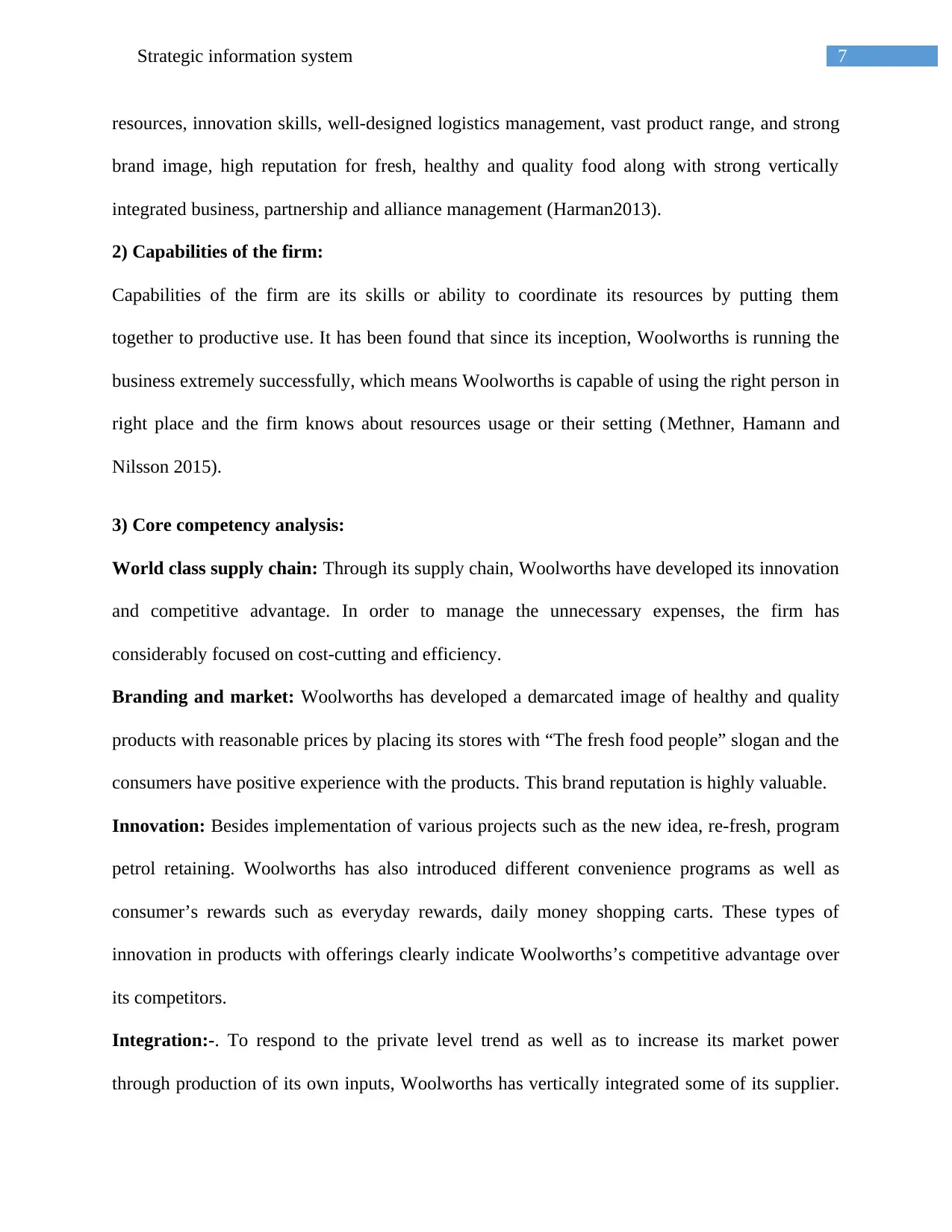
7Strategic information system
resources, innovation skills, well-designed logistics management, vast product range, and strong
brand image, high reputation for fresh, healthy and quality food along with strong vertically
integrated business, partnership and alliance management (Harman2013).
2) Capabilities of the firm:
Capabilities of the firm are its skills or ability to coordinate its resources by putting them
together to productive use. It has been found that since its inception, Woolworths is running the
business extremely successfully, which means Woolworths is capable of using the right person in
right place and the firm knows about resources usage or their setting (Methner, Hamann and
Nilsson 2015).
3) Core competency analysis:
World class supply chain: Through its supply chain, Woolworths have developed its innovation
and competitive advantage. In order to manage the unnecessary expenses, the firm has
considerably focused on cost-cutting and efficiency.
Branding and market: Woolworths has developed a demarcated image of healthy and quality
products with reasonable prices by placing its stores with “The fresh food people” slogan and the
consumers have positive experience with the products. This brand reputation is highly valuable.
Innovation: Besides implementation of various projects such as the new idea, re-fresh, program
petrol retaining. Woolworths has also introduced different convenience programs as well as
consumer’s rewards such as everyday rewards, daily money shopping carts. These types of
innovation in products with offerings clearly indicate Woolworths’s competitive advantage over
its competitors.
Integration:-. To respond to the private level trend as well as to increase its market power
through production of its own inputs, Woolworths has vertically integrated some of its supplier.
resources, innovation skills, well-designed logistics management, vast product range, and strong
brand image, high reputation for fresh, healthy and quality food along with strong vertically
integrated business, partnership and alliance management (Harman2013).
2) Capabilities of the firm:
Capabilities of the firm are its skills or ability to coordinate its resources by putting them
together to productive use. It has been found that since its inception, Woolworths is running the
business extremely successfully, which means Woolworths is capable of using the right person in
right place and the firm knows about resources usage or their setting (Methner, Hamann and
Nilsson 2015).
3) Core competency analysis:
World class supply chain: Through its supply chain, Woolworths have developed its innovation
and competitive advantage. In order to manage the unnecessary expenses, the firm has
considerably focused on cost-cutting and efficiency.
Branding and market: Woolworths has developed a demarcated image of healthy and quality
products with reasonable prices by placing its stores with “The fresh food people” slogan and the
consumers have positive experience with the products. This brand reputation is highly valuable.
Innovation: Besides implementation of various projects such as the new idea, re-fresh, program
petrol retaining. Woolworths has also introduced different convenience programs as well as
consumer’s rewards such as everyday rewards, daily money shopping carts. These types of
innovation in products with offerings clearly indicate Woolworths’s competitive advantage over
its competitors.
Integration:-. To respond to the private level trend as well as to increase its market power
through production of its own inputs, Woolworths has vertically integrated some of its supplier.
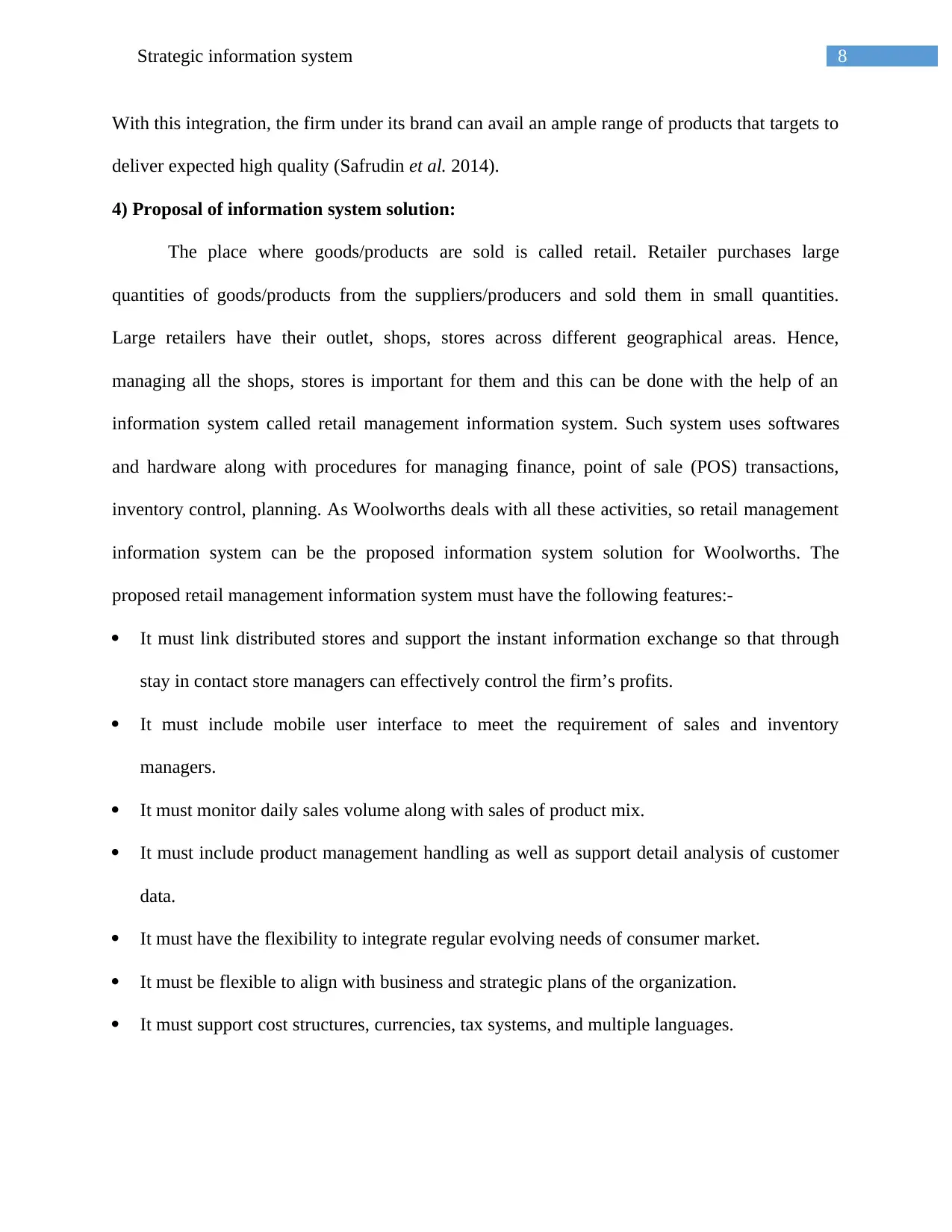
8Strategic information system
With this integration, the firm under its brand can avail an ample range of products that targets to
deliver expected high quality (Safrudin et al. 2014).
4) Proposal of information system solution:
The place where goods/products are sold is called retail. Retailer purchases large
quantities of goods/products from the suppliers/producers and sold them in small quantities.
Large retailers have their outlet, shops, stores across different geographical areas. Hence,
managing all the shops, stores is important for them and this can be done with the help of an
information system called retail management information system. Such system uses softwares
and hardware along with procedures for managing finance, point of sale (POS) transactions,
inventory control, planning. As Woolworths deals with all these activities, so retail management
information system can be the proposed information system solution for Woolworths. The
proposed retail management information system must have the following features:-
It must link distributed stores and support the instant information exchange so that through
stay in contact store managers can effectively control the firm’s profits.
It must include mobile user interface to meet the requirement of sales and inventory
managers.
It must monitor daily sales volume along with sales of product mix.
It must include product management handling as well as support detail analysis of customer
data.
It must have the flexibility to integrate regular evolving needs of consumer market.
It must be flexible to align with business and strategic plans of the organization.
It must support cost structures, currencies, tax systems, and multiple languages.
With this integration, the firm under its brand can avail an ample range of products that targets to
deliver expected high quality (Safrudin et al. 2014).
4) Proposal of information system solution:
The place where goods/products are sold is called retail. Retailer purchases large
quantities of goods/products from the suppliers/producers and sold them in small quantities.
Large retailers have their outlet, shops, stores across different geographical areas. Hence,
managing all the shops, stores is important for them and this can be done with the help of an
information system called retail management information system. Such system uses softwares
and hardware along with procedures for managing finance, point of sale (POS) transactions,
inventory control, planning. As Woolworths deals with all these activities, so retail management
information system can be the proposed information system solution for Woolworths. The
proposed retail management information system must have the following features:-
It must link distributed stores and support the instant information exchange so that through
stay in contact store managers can effectively control the firm’s profits.
It must include mobile user interface to meet the requirement of sales and inventory
managers.
It must monitor daily sales volume along with sales of product mix.
It must include product management handling as well as support detail analysis of customer
data.
It must have the flexibility to integrate regular evolving needs of consumer market.
It must be flexible to align with business and strategic plans of the organization.
It must support cost structures, currencies, tax systems, and multiple languages.
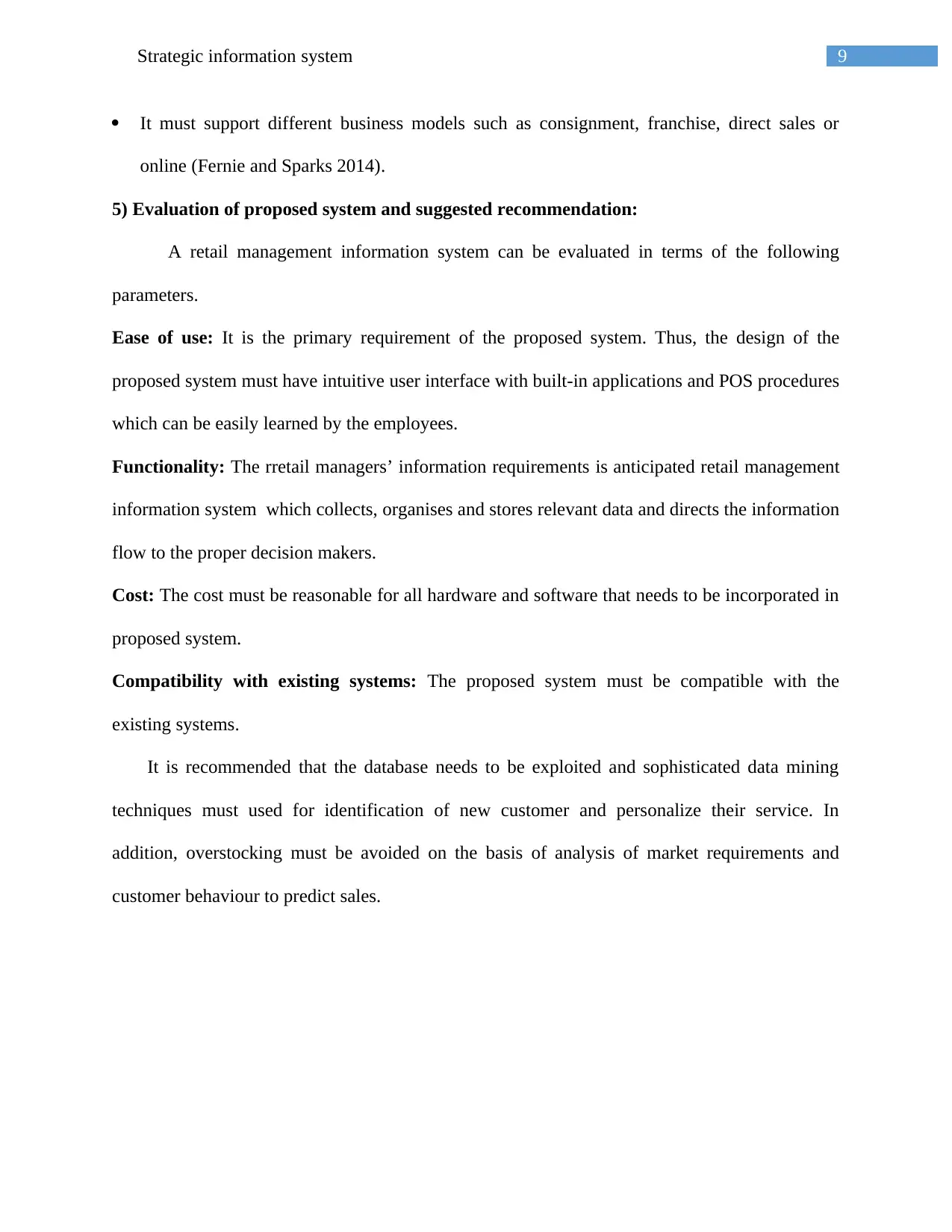
9Strategic information system
It must support different business models such as consignment, franchise, direct sales or
online (Fernie and Sparks 2014).
5) Evaluation of proposed system and suggested recommendation:
A retail management information system can be evaluated in terms of the following
parameters.
Ease of use: It is the primary requirement of the proposed system. Thus, the design of the
proposed system must have intuitive user interface with built-in applications and POS procedures
which can be easily learned by the employees.
Functionality: The rretail managers’ information requirements is anticipated retail management
information system which collects, organises and stores relevant data and directs the information
flow to the proper decision makers.
Cost: The cost must be reasonable for all hardware and software that needs to be incorporated in
proposed system.
Compatibility with existing systems: The proposed system must be compatible with the
existing systems.
It is recommended that the database needs to be exploited and sophisticated data mining
techniques must used for identification of new customer and personalize their service. In
addition, overstocking must be avoided on the basis of analysis of market requirements and
customer behaviour to predict sales.
It must support different business models such as consignment, franchise, direct sales or
online (Fernie and Sparks 2014).
5) Evaluation of proposed system and suggested recommendation:
A retail management information system can be evaluated in terms of the following
parameters.
Ease of use: It is the primary requirement of the proposed system. Thus, the design of the
proposed system must have intuitive user interface with built-in applications and POS procedures
which can be easily learned by the employees.
Functionality: The rretail managers’ information requirements is anticipated retail management
information system which collects, organises and stores relevant data and directs the information
flow to the proper decision makers.
Cost: The cost must be reasonable for all hardware and software that needs to be incorporated in
proposed system.
Compatibility with existing systems: The proposed system must be compatible with the
existing systems.
It is recommended that the database needs to be exploited and sophisticated data mining
techniques must used for identification of new customer and personalize their service. In
addition, overstocking must be avoided on the basis of analysis of market requirements and
customer behaviour to predict sales.
Secure Best Marks with AI Grader
Need help grading? Try our AI Grader for instant feedback on your assignments.
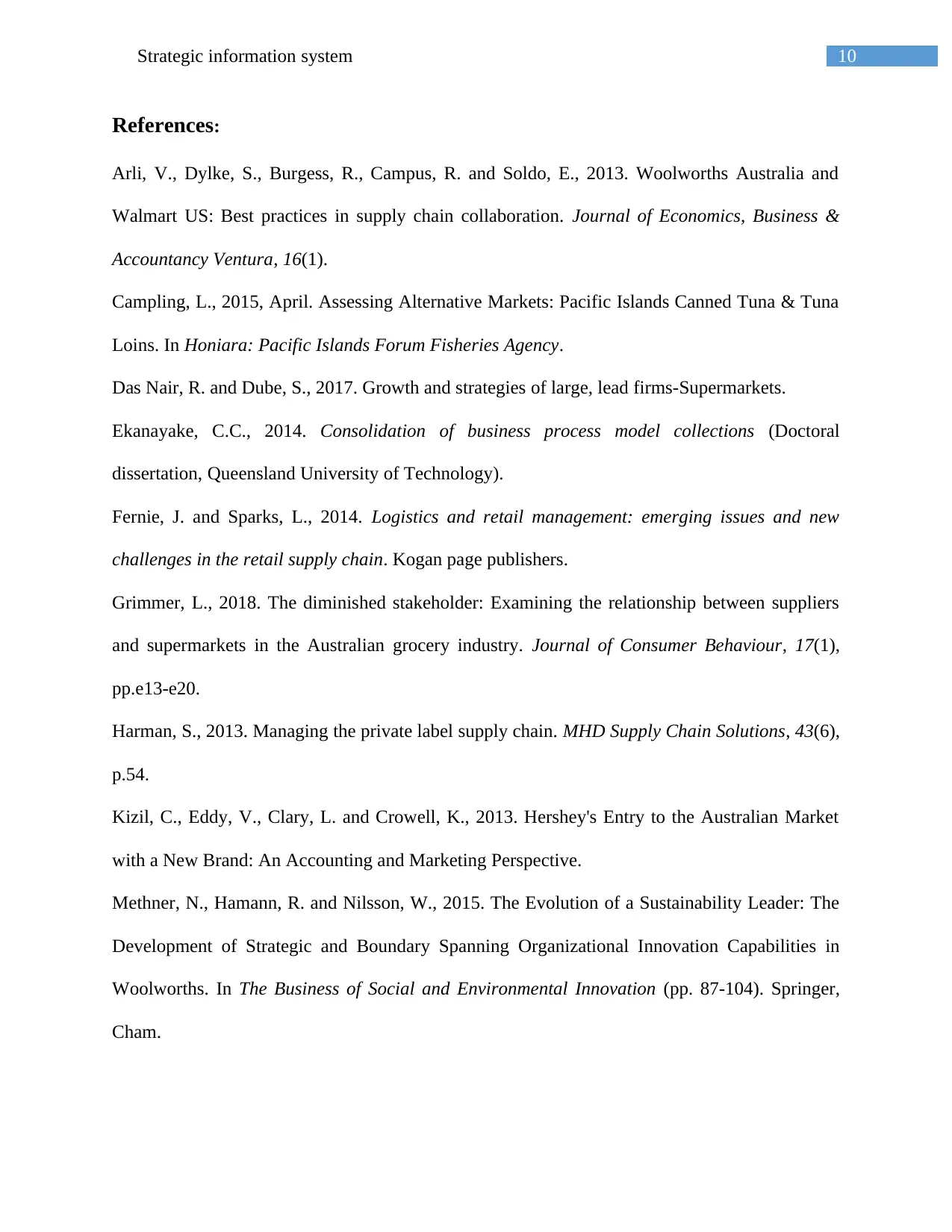
10Strategic information system
References:
Arli, V., Dylke, S., Burgess, R., Campus, R. and Soldo, E., 2013. Woolworths Australia and
Walmart US: Best practices in supply chain collaboration. Journal of Economics, Business &
Accountancy Ventura, 16(1).
Campling, L., 2015, April. Assessing Alternative Markets: Pacific Islands Canned Tuna & Tuna
Loins. In Honiara: Pacific Islands Forum Fisheries Agency.
Das Nair, R. and Dube, S., 2017. Growth and strategies of large, lead firms-Supermarkets.
Ekanayake, C.C., 2014. Consolidation of business process model collections (Doctoral
dissertation, Queensland University of Technology).
Fernie, J. and Sparks, L., 2014. Logistics and retail management: emerging issues and new
challenges in the retail supply chain. Kogan page publishers.
Grimmer, L., 2018. The diminished stakeholder: Examining the relationship between suppliers
and supermarkets in the Australian grocery industry. Journal of Consumer Behaviour, 17(1),
pp.e13-e20.
Harman, S., 2013. Managing the private label supply chain. MHD Supply Chain Solutions, 43(6),
p.54.
Kizil, C., Eddy, V., Clary, L. and Crowell, K., 2013. Hershey's Entry to the Australian Market
with a New Brand: An Accounting and Marketing Perspective.
Methner, N., Hamann, R. and Nilsson, W., 2015. The Evolution of a Sustainability Leader: The
Development of Strategic and Boundary Spanning Organizational Innovation Capabilities in
Woolworths. In The Business of Social and Environmental Innovation (pp. 87-104). Springer,
Cham.
References:
Arli, V., Dylke, S., Burgess, R., Campus, R. and Soldo, E., 2013. Woolworths Australia and
Walmart US: Best practices in supply chain collaboration. Journal of Economics, Business &
Accountancy Ventura, 16(1).
Campling, L., 2015, April. Assessing Alternative Markets: Pacific Islands Canned Tuna & Tuna
Loins. In Honiara: Pacific Islands Forum Fisheries Agency.
Das Nair, R. and Dube, S., 2017. Growth and strategies of large, lead firms-Supermarkets.
Ekanayake, C.C., 2014. Consolidation of business process model collections (Doctoral
dissertation, Queensland University of Technology).
Fernie, J. and Sparks, L., 2014. Logistics and retail management: emerging issues and new
challenges in the retail supply chain. Kogan page publishers.
Grimmer, L., 2018. The diminished stakeholder: Examining the relationship between suppliers
and supermarkets in the Australian grocery industry. Journal of Consumer Behaviour, 17(1),
pp.e13-e20.
Harman, S., 2013. Managing the private label supply chain. MHD Supply Chain Solutions, 43(6),
p.54.
Kizil, C., Eddy, V., Clary, L. and Crowell, K., 2013. Hershey's Entry to the Australian Market
with a New Brand: An Accounting and Marketing Perspective.
Methner, N., Hamann, R. and Nilsson, W., 2015. The Evolution of a Sustainability Leader: The
Development of Strategic and Boundary Spanning Organizational Innovation Capabilities in
Woolworths. In The Business of Social and Environmental Innovation (pp. 87-104). Springer,
Cham.
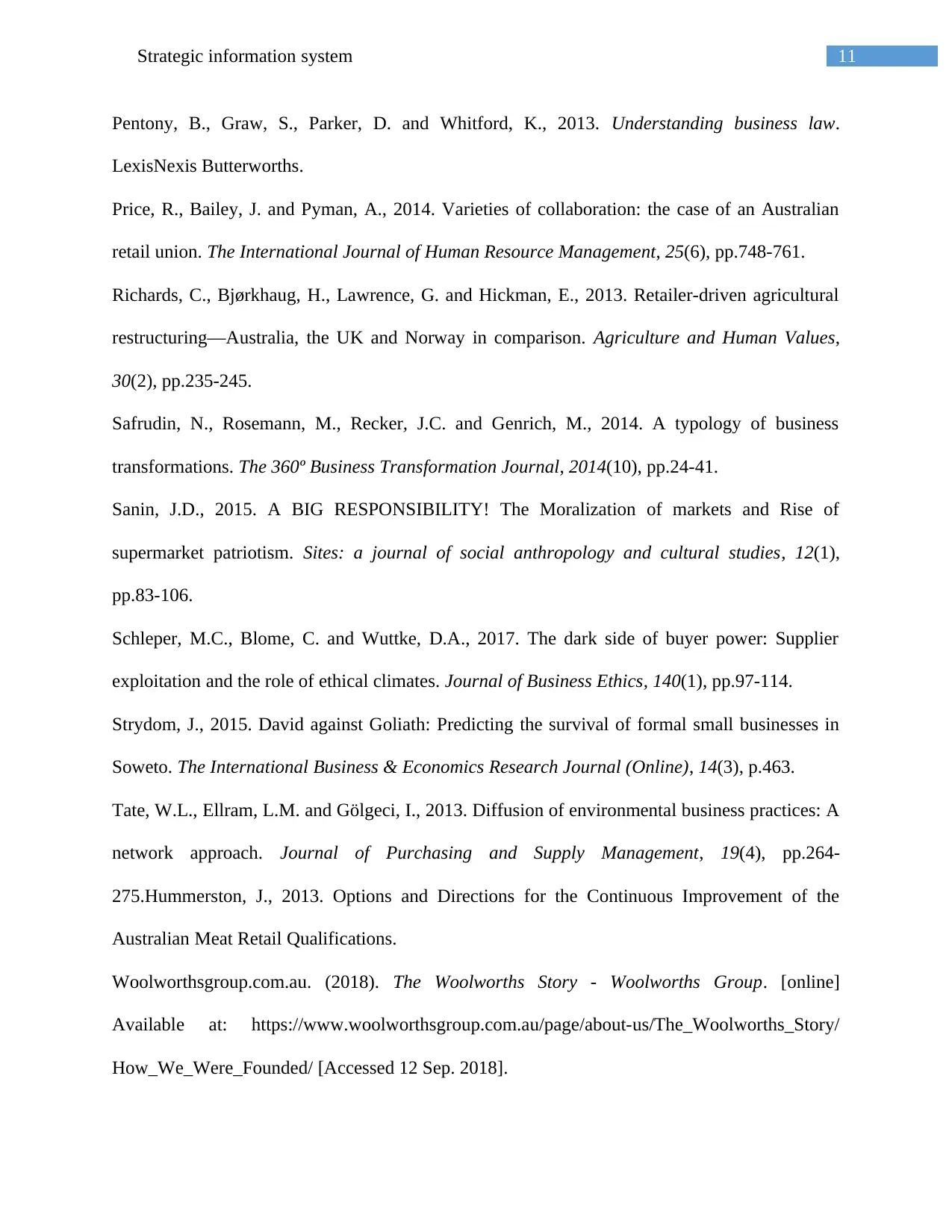
11Strategic information system
Pentony, B., Graw, S., Parker, D. and Whitford, K., 2013. Understanding business law.
LexisNexis Butterworths.
Price, R., Bailey, J. and Pyman, A., 2014. Varieties of collaboration: the case of an Australian
retail union. The International Journal of Human Resource Management, 25(6), pp.748-761.
Richards, C., Bjørkhaug, H., Lawrence, G. and Hickman, E., 2013. Retailer-driven agricultural
restructuring—Australia, the UK and Norway in comparison. Agriculture and Human Values,
30(2), pp.235-245.
Safrudin, N., Rosemann, M., Recker, J.C. and Genrich, M., 2014. A typology of business
transformations. The 360º Business Transformation Journal, 2014(10), pp.24-41.
Sanin, J.D., 2015. A BIG RESPONSIBILITY! The Moralization of markets and Rise of
supermarket patriotism. Sites: a journal of social anthropology and cultural studies, 12(1),
pp.83-106.
Schleper, M.C., Blome, C. and Wuttke, D.A., 2017. The dark side of buyer power: Supplier
exploitation and the role of ethical climates. Journal of Business Ethics, 140(1), pp.97-114.
Strydom, J., 2015. David against Goliath: Predicting the survival of formal small businesses in
Soweto. The International Business & Economics Research Journal (Online), 14(3), p.463.
Tate, W.L., Ellram, L.M. and Gölgeci, I., 2013. Diffusion of environmental business practices: A
network approach. Journal of Purchasing and Supply Management, 19(4), pp.264-
275.Hummerston, J., 2013. Options and Directions for the Continuous Improvement of the
Australian Meat Retail Qualifications.
Woolworthsgroup.com.au. (2018). The Woolworths Story - Woolworths Group. [online]
Available at: https://www.woolworthsgroup.com.au/page/about-us/The_Woolworths_Story/
How_We_Were_Founded/ [Accessed 12 Sep. 2018].
Pentony, B., Graw, S., Parker, D. and Whitford, K., 2013. Understanding business law.
LexisNexis Butterworths.
Price, R., Bailey, J. and Pyman, A., 2014. Varieties of collaboration: the case of an Australian
retail union. The International Journal of Human Resource Management, 25(6), pp.748-761.
Richards, C., Bjørkhaug, H., Lawrence, G. and Hickman, E., 2013. Retailer-driven agricultural
restructuring—Australia, the UK and Norway in comparison. Agriculture and Human Values,
30(2), pp.235-245.
Safrudin, N., Rosemann, M., Recker, J.C. and Genrich, M., 2014. A typology of business
transformations. The 360º Business Transformation Journal, 2014(10), pp.24-41.
Sanin, J.D., 2015. A BIG RESPONSIBILITY! The Moralization of markets and Rise of
supermarket patriotism. Sites: a journal of social anthropology and cultural studies, 12(1),
pp.83-106.
Schleper, M.C., Blome, C. and Wuttke, D.A., 2017. The dark side of buyer power: Supplier
exploitation and the role of ethical climates. Journal of Business Ethics, 140(1), pp.97-114.
Strydom, J., 2015. David against Goliath: Predicting the survival of formal small businesses in
Soweto. The International Business & Economics Research Journal (Online), 14(3), p.463.
Tate, W.L., Ellram, L.M. and Gölgeci, I., 2013. Diffusion of environmental business practices: A
network approach. Journal of Purchasing and Supply Management, 19(4), pp.264-
275.Hummerston, J., 2013. Options and Directions for the Continuous Improvement of the
Australian Meat Retail Qualifications.
Woolworthsgroup.com.au. (2018). The Woolworths Story - Woolworths Group. [online]
Available at: https://www.woolworthsgroup.com.au/page/about-us/The_Woolworths_Story/
How_We_Were_Founded/ [Accessed 12 Sep. 2018].
1 out of 12
Related Documents
Your All-in-One AI-Powered Toolkit for Academic Success.
+13062052269
info@desklib.com
Available 24*7 on WhatsApp / Email
![[object Object]](/_next/static/media/star-bottom.7253800d.svg)
Unlock your academic potential
© 2024 | Zucol Services PVT LTD | All rights reserved.




